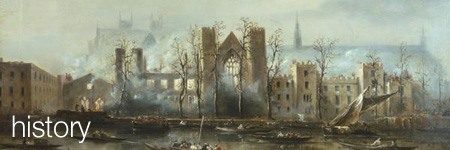
Eastcheap
City (EC3) Took its name from a market anciently there kept for the serving of the east part of the City. (Reference: Strype's Stow, Bk. ii, p. 182) A market at one time almost as famous as Westcheap (now Cheapside) . The origin is of course chepe, "a market." Here were many hostelries, including the "Boar's Head" Tavern, frequented by Shakespeare and made famous for all time by him. Famous in the olden time for those scenes of jollity, when "the cooks cried 'hot ribs of beef roasted, pies well baked, and other victuals,' with clattering of pewter pots, harp, pipe and sawtrie." There is perhaps no spot in London which recalls so vividly to our imagination the romance of the olden time as Eastcheap. Who is there who has ever strolled along this classic ground without having pictured to himself the "Boar's Head" Tavern, such as when it resounded to the jokes and merriment of Sir John Falstaff and his boon companions? "The character of Falstaff," says Goldsmith, in one of his charming Essays, "even with all his faults, gives me more consolation than the most studied efforts of wisdom. . Sure I am well able to be as merry, though not so comical as he. Age, care, wisdom, reflection, begone here's to the memory of Shakespeare, Falstaff, and all the merry men of Eastcheap! Such were the reflections that naturally arose while I sat at the 'Boar's Head' Tavern, still kept at Eastcheap. Here, by a pleasant fire, in the very room where old John Falstaff cracked his jokes, in the very chair which was sometimes honoured by Prince Henry, and sometimes polluted by his immoral merry companions, I sat and ruminated on the follies of youth." The "Boar's Head" of Shakespeare, which stood in Great Eastcheap, perished in the Fire of London. A tavern bearing the same name was erected on its site, having in front of it a boar's head cut in stone with the date 1688. It was taken down in 1831, to make room for the approaches to New London Bridge. The object which most nearly marks the site of the old tavern is the statue of King William IV. (Reference: Jesse's London, vol. II, pp. 317-18)